W.Koester–K.Ammann
Route 20 Chess Club
Freeport, Illinois, Jan. 19, 2010
1.c4 c5 2.g3!? g6 3.Bg2 Bg7
Yep, it's Bill's Opening. Months ago, I worked out what seemed like a fairly effective 1...e5 reply, but it had been so long, I'd forgotten it, so I opted for the symmetrical response instead.
4.Qb3 Qb6 5.Qxb6 axb6 6.Nc3 Nf6 7.Nf3 0-0 8.d4 d6 9.dxc5
Cedes a slight advantage to black. White is better off castling.
9...bxc5 10.0-0 Be6 11.Nd2 Ra7
I missed the better defensive move 11...Nc6, which dares black to trade off his fianchettoed bishop (black is unlikely to take the dare).
12.Nb5 Ra6
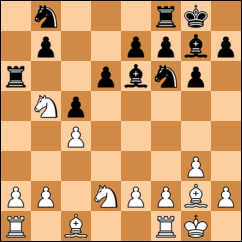
After searching desperately for anything better, I finally concede that the pawn is lost.
13.Nc7
And Bill doesn't take it! After the game, I asked him why; he said that his target was the bishop on e6. The advantage gained by 13.Bxb7 is slight, but according to Fritz, there's no advantage at all in going after the bishop.
13...Rb6 14.Nxe6 fxe6 15.a4 d5
15...Nc6 16.a5 Ra6 17.Nb3 would keep the tension with an even position. My move overlooks the troublesome potential of 16.a5.
16.Bh3 Na6
16...Ra6 is still better.
17.a5 Rd6 18.cxd5
According to Fritz, white's best move by far is the counterintuitive 18.Nf3!?, leading into the sequence 18...Ne4 19.Bf4 Rc6 20.Ne5 Bxe5 21.Bxe5. I'm not sure either one of us ever considered that sequence, even briefly.
18...exd5 19.Nb3 Nd7 20.Bf4
This position put me on tilt, and looking back on it now, I can't figure out why. The blocking move 20...e5 is simple, unimpeachable and ostensibly obvious, yet I don't recall ever considering it seriously. Was I afraid of losing my knight? But the knight is easily avenged by the rook. I was responding to some dire threat that wasn't there, which explains my next move, a bizarre (in retrospect) attempt at counterplay.
20...Bxb2??
21.Bxd6 Bxa1 22.Rxa1 exd6 23.Bxd7 would cost me a knight. But Bill is as tilted by my "counterplay" as I was by the position that inspired it.
21.Rab1 Be5 22.Bxd7 Bxf4 23.Bb5
23...c4
Wins space, blocks in the bishop and counterattacks the knight. But this move, at best, maintains an even position. Significantly more advantageous is the simple retreat 23...Be5, followed by 24.Bxa6 bxa6 (not 24...Rxa6 25.Nxc5 Ra7 26.Nd7) 25.Nxc5 Bd4.
24.Nd4??
Spooked by the threat, Bill's knight springs out of the way, allowing me to do what I should have done a moment ago -- and claim a decisive advantage.
24...Be5 25.e3 Nc5 26.Rfd1 Nd3
Takes a defender away from a6, facilitating the pawn advance and giving up some of that newly acquired advantage. Fritz recommends just the opposite: 26...Ra8.
27.f4 Bxd4 28.exd4 b6
Fritz still prefers 28...Ra8. Now Bill has a chance to get tricky.
29.a6! Ra8
That woke me up.
30.Rd2 Kf7
Everything else is nice and locked up . . . time to take my king for a stroll!
31.Re2 Kf6 32.Kg2 e6 33.Kf3 h5 34.h4 Ra7 35.Ke3 Kf5 36.Kf3 Re7 37.Ra1 Ra7
38.Ba4??
Bill inexplicably hangs his pawn and pins his bishop in one stroke.
38...Rxa6 39.Rea2 Nb4 40.Rb2 Nd3
40...b5, attacking the pinned bishop, was better, but I hesitated because I didn't want to hang my knight. If I'd been able to read it through, I'd have seen that 41.Rxb4 Rxa4 42.Raxa4 bxa4 leaves me in a perfectly fine position, up two passed pawns.
41.Rba2
I'm wheeling out the JumboTron, because this was the position on which the entire game hinged: a repetition of the position at move 39. Ahead by two pawns, one of them passed, I was hungry for the win and afraid that if I returned my knight to b4, Bill would go for the draw.
But when we discussed it after the game, Bill revealed that he had no such intention. If I'd played 41...Nb4, his plan was 42.Rg2 b5 43.g4+ hxg4 44.Rxg4. Assuming that I'd play 44...bxa4, he anticipated the continuation 45.Rg5+ Kf6 46.Rg1 (diagram). In short, he was going for the kill.
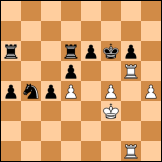 But he'd made a faulty assumption: I'd thought about it, and I'd decided that my pawn superiority made it highly desirable for me to knock off one of his rooks if I could. Therefore, if I had the chance, I intended to take the pinned bishop not with my b-pawn but with my rook. 44...Rxa4 45.Rg5+ Kf6 46.Rxa4 bxa4 47.Rg1 maintains an advantage for black.
But he'd made a faulty assumption: I'd thought about it, and I'd decided that my pawn superiority made it highly desirable for me to knock off one of his rooks if I could. Therefore, if I had the chance, I intended to take the pinned bishop not with my b-pawn but with my rook. 44...Rxa4 45.Rg5+ Kf6 46.Rxa4 bxa4 47.Rg1 maintains an advantage for black.Plus, the more we looked at it, Bill's plan was far from a sure thing. If I disregarded the threat of Rxg6+ and played 46...a3, Bill would find it hard to finish me off after 47.Rxg6+ Kf7 48.Rg7+ Kf8 49.Rg8+ Kf7 50.R1g7+ Kf6. It's still possible that I might screw up, but unless he puts the mating attack on hold and shifts his seventh-rank rook to c7 (good) or h7 (best), it's looking decidedly drawish.
Meanwhile, neither one of us had considered 41...Kf6, a Zen-like move that gives white all sorts of chances to weaken his own position.
So what move did I actually choose?
41...c3
It's not a horrible move -- well, not unless black thinks of 42.Bc2! Rxa2 43.Bxd3+ Kf6 44.Rxa2, which will leave me down a minor piece. But it's significantly worse than 41...Kf6 or 41...Nb4.
42.Bb5 Rxa2??
Like the Democratic Party, I must have something in my brain that's averse to winning in a won position. I could have kept my advantage with 42...Ne1+! 43.Ke2 Rxa2+ 44.Rxa2 Ke4 45.Kxe1 Kxd4.
43.Bxd3+ Kf6 44.Rxa2 Rc6 45.Bc2
A slight stumble. Bishops aren't good blockaders of pawns, and that pawn isn't going anywhere anyway, not with a white rook on a2. Better is 45.Ke2, bringing the king over to help out against white's passed pawns.
45...b5 46.Ke3 b4 47.Kd3 Kf5
47...Rb6 is better, putting the rook behind the charging pawn.
48.Ba4??
Practically inviting me to pin him again! However, it's not so clear-cut this time: White is in no hurry to go anywhere on the queenside, I have no other unit handy to attack the pinned bishop with, and I'd be a fool to sacrifice a sixth-rank pawn for a bishop (counting on Bxc2 instead of Rxc2 is just hope chess). White can sit tight and play 49.Ke3, thwarting my invasion Kg4xg3. Best is the common-sense 48...Rb6, transferring my rook from one bodyguard duty to another. The move I choose is no prizewinner -- but neither is Bill's response to it.
48...Rc7? 49.Bc2??
49.Bd1 also would have stopped my kingside invasion.
49...Kg4 50.Ra6 Kxg3?
I needed to play 50...Re7 first.
51.Rxe6 Kxh4
Abandoning another pawn unnecessarily.
52.Rxg6 Rb7
I'm just getting sloppy here. Why not 52...Rf7, pulling white's king back from the queenside?
53.Rg5??
53.Bb3 Rf7 54.Bxd5 Rxf4 55.Rb6, and my chances of promotion would have been bleak: the queenside pawns are sitting ducks, and the bishop guards the h-pawn's promotion square. Bill's move gives me one last-ditch opportunity.
53...b3 54.Kxc3 bxc2 55.Kxc2 Rb4
The correct move was 55...Rf7, but I'm not done for yet.
56.Kc3 Rb5 57.Re5 Kg4 58.f5??
58.Rg5+ would have put my king back in his place. Suddenly, I have the advantage again!
58...h4 59.f6 h3??
And just as suddenly, it's gone! For this to work, I have to get my rook over to the kingside, and the best way to do that is 59...Rb6 (nudging the pawn forward) 60.f7 Rf6, and preventing the promotion of my h-pawn will cost white his rook. I'm not going to win the promotion race in a straight sprint.
60.f7 Rb8 61.Re8 h2 62.Rg8+ Kh3 (62...Kh5 was better, in the sense that being stranded on a desert island is better than being eaten by sharks) 63.Rxb8 h1Q 64.Rh8+! Kg2 65.Rxh1 Kxh1 66.f8Q 1-0

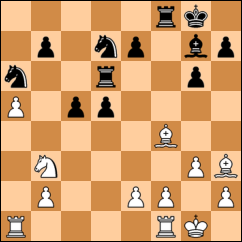
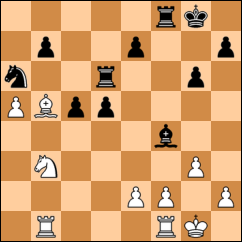
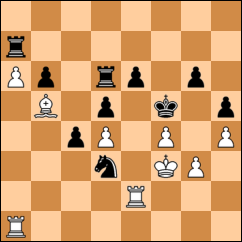
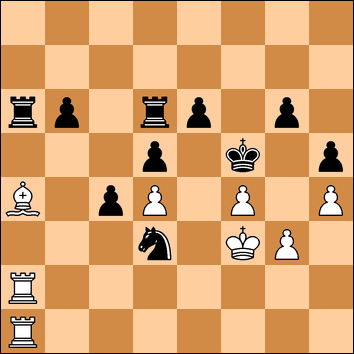
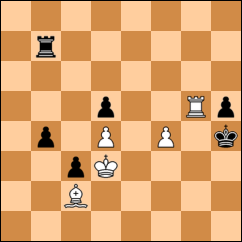



0 comments:
Post a Comment